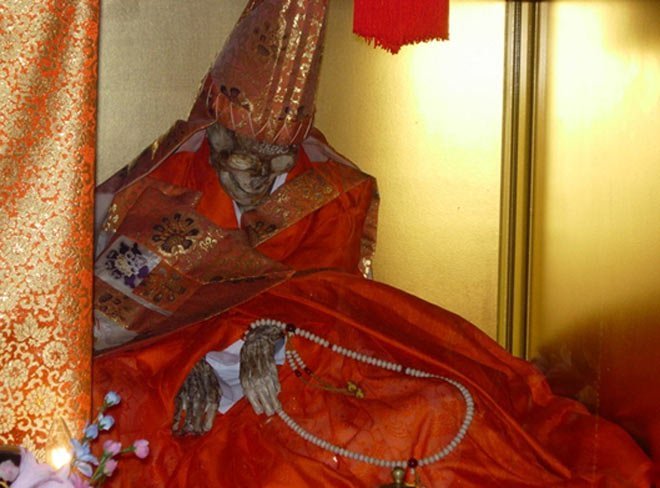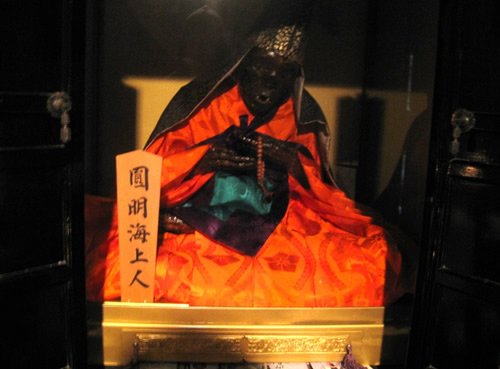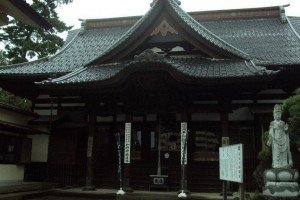
Image source
Greetings friends, I bring this day an interesting article to all you, about the art of mummification.In the mountains of northern Japan there is a group of mummies that do not resemble any other. They were priests who decided to mummify themselves when they were still alive. They belong to a religious group called "Shingon Buddhism", and practiced self-denial as a way to prepare the mind to ignore the physical world, and concentrate on spirituality. These priests wanted to leave their mummies as a symbol of great holiness, to inspire the Buddhists who survived them.
STEPS FOR AUTOMOMIFICATION.
SPECIAL DIETS
Kukai's mummification method was a long and painful process that lasted about ten years. The first step was to change the diet to lose body fat. The priests stopped eating their usual food based on rice and wheat, and instead ate pine cones, barks and roots.TÉ URUSHI
Next, the priests drank tea prepared with sap from the urushi tree, which was normally used to varnish furniture. The tea was poisonous and made the priests vomit and sweat, which dehydrated the bodies. They believed that this contributed to preserve the body after death.ARSENIC
Towards the end of the process of mummification, the priests drank water from a sacred spring. Recently, scientists discovered that the water in this spring contains arcenic, a poison that is stored in the tissues and kills the bacteria that cause the decomposition of the body after death.SANDWICH
Finally, the priest was walled in a cell for a thousand days. The interior of the cell received air through a tube. The priest would ring a bell every day that he was still alive. When the tolling ceased, the tube was sealed. After a thousand days, the followers of the priest opened the cell and verified if the process had worked.
MOMIA ON DISPLAY.
This is the mummy of Shinyokai, a priest who died at age 95 in 1788. Buddhists believe that after death we reincarnate in new bodies. The goal of Buddhism is to escape this cycle of death and rebirth, reaching a sacred state called "enlightenment". It was believed that self-metering was a sign that the Buddhist priest had attained enlightenment. Like other of these mummies, Shinyokai is dressed in rich tunics and is displayed in a Buddhist temple, where he is worshiped as if he were a God.

Image source
CHUKAI.
An automomified body is called shokushinbutsu, which means "Body Buddha". This mummy is the shokushinbutsu of Chukai (1697 - 1755). Like other Shingon monks, I consecrate years of teaching your body to ignore pain before mummifying. One way to achieve this was to sit in a room full of pepper smoke that burned.

Image source
TETSUMONKAI.
This is the shokushinbutsu of Tetsumonkai, who died in 1829. It is preserved in the Churenji temple, in the province of Yamagata. Legend has it that he became a Buddhist monk after killing two samurai in his own defense. Regretful of his actions, I practice the denial of himself. One of the punishments that was self-inflicted was to sit in a lotus position (with legs raised and feet above the thighs) under an icy waterfall.

Image source
KUKAI.
This is a statue of Kukai (774 - 835 d.C), the Buddhist monk who introduced Shingon Buddhism into Japan. After studying the different forms of Buddhism in China at the beginning of the 9th century, he established a monastery in Japan. There a new form of Buddhism was practiced. Most Buddhists believe that many lives are needed to attain enlightenment; Kukai thought that it was possible to achieve it in a single one by denying oneself and automomification.

Image source
TEMPLE KAIKOJI
In the Koikoji temple, in Sakata, the mummies of Chukai (1697 - 1755) and Enyokai (1767 - 1822) are preserved. Generations of Buddhist priests have guarded them. Currently, more than 10 million Japanese, a tenth of the country's Buddhists, are followers of Shingon Buddhism. However, automomification is illegal since the end of the 19th century.

Image source
I hope all of you liked it, this interesting article, I found it important to share it with my whole family of steemit, for you and for you.
That process sounded kind of extreme, I didn't knew they used poison on themselves, and being alone in a cell... this process clearly requires a special mind to go trough all of this.
Mentally very prepared, are years of preparing psychologically, to reach the highest state .. Thanks for reading